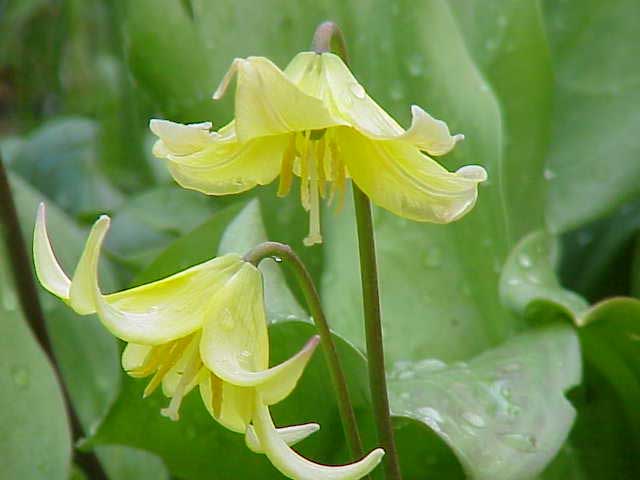
Erythronium revolutum (*)
Classification System: APG IV
Superregnum: Eukaryota
Regnum: Plantae
Cladus: Angiosperms
Cladus: Monocots
Ordo: Liliales
Familia: Liliaceae
Subfamilia: Lilioideae
Genus: Erythronium
Species: Erythronium revolutum
Name
Erythronium revolutum Sm. in A.Rees, Cycl. 13: n.º 3 (1809)
Synonyms
Homotypic
Erythronium grandiflorum f. revolutum (Sm.) Voss, Vilm. Blumengärtn. ed. 3, 1: 1115 (1895)
Heterotypic
Erythronium grandiflorum var. smithii Hook., Fl. Bor.-Amer. 2: 182 (1838)
Erythronium smithii Orcutt, W. Amer. Sci. 7: 129 (1891)
Erythronium johnsonii Bol., Erythea 3: 127 (1895)
Erythronium revolutum var. johnsonii (Bol.) Purdy in L.H.Bailey, Cycl. Amer. Hort.: 548 (1900)
References
A. Rees, Cycl. 13: Erythronium no. 3. 1809
Erythronium revolutum is a species of flowering plant in the family Liliaceae which is known by several common names, including mahogany fawn lily, coast fawn lily, and pink fawn lily. It is native to the west coast of North America.
Description
Erythronium revolutum, a hardy perennial wildflower, grows from an oval-shaped bulb 3–5 cm (1–2 in) long, producing usually two wide, flat, mottled green leaves near the ground. It is indigenous to Northwest Washington.
The plant flowers between March and June.[2] Each bulb sends up a long, naked stalk bearing one or two showy lily flowers. The stalk bows at the end so that the face of the flower points at the ground. There are six tepals in shades of pink or light purple which may have yellow or white spotting toward the center of the flower. The tepals may be straight or recurved so far that their tips meet behind the flower; they tend to recurve further as the flower ages. The anthers are bright yellow.
Erythronium revolutum can be distinguished from related species by its pink flowers, swollen anther filaments and mottled leaves.[2]
The fruit is a capsule up to 6 cm (2 in) long.
Distribution
Erythronium revolutum is native to western North America, from coastal Northern California to British Columbia, including Vancouver Island.[3]
Ecology
Erythronium revolutum is most abundant within 100 miles (161 km) of the coast, at altitudes of less than 1000 m.[3] The plant is found in moist places such as streambanks, bogs, and wet redwood and mixed evergreen forest understory.[2][3] It is slow-growing, taking 5–7 years to form a flowering size bulb,[4] and therefore is slow to establish in new locations.
These habitats are threatened in the wild and in addition, E. revolutum may be threatened by collection for horticulture and soil compaction by forestry machinery.[4]
Growing in the woodland garden at Knightshayes Court, Devon (UK)
Cultivation
Erythronium revolutum is cultivated as an ornamental plant, for use in traditional and natural gardens. Its combination of attractively patterned leaves and graceful flowers in mid spring make it a desirable plant. The best forms (often called var. johnstonii) have darker, richer pink flowers and well marked foliage. It should be planted in a shady spot (ideally beneath deciduous trees or shrubs) in humus-rich soil that does not dry out and is rather damp in spring. It will naturalise over time by self-seeding, though as seedlings take several years to reach flowering size this can be a slow process.
References
The Plant List: Erythronium revolutum. Royal Botanic Gardens, Kew and Missouri Botanic Gardens. Accessed November 18, 2014
Phillips R., Rix B. 1989. Bulbs (2nd Edition). Pan Books Ltd., London
Mathew, B. 1987. The Smaller Bulbs. B.T. Batsford Ltd., London.
"Sholars T., Golec C. 2007. Rare plants of the Redwood Forest and Forest Management Effects. USDA Forest Service Gen. Tech. Rep. PSW-GTR-194" (PDF). Archived from the original (PDF) on 2011-10-27. Retrieved 2014-12-06.
Retrieved from "http://en.wikipedia.org/"
All text is available under the terms of the GNU Free Documentation License

